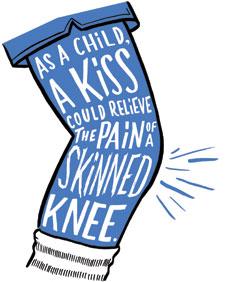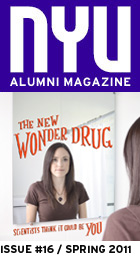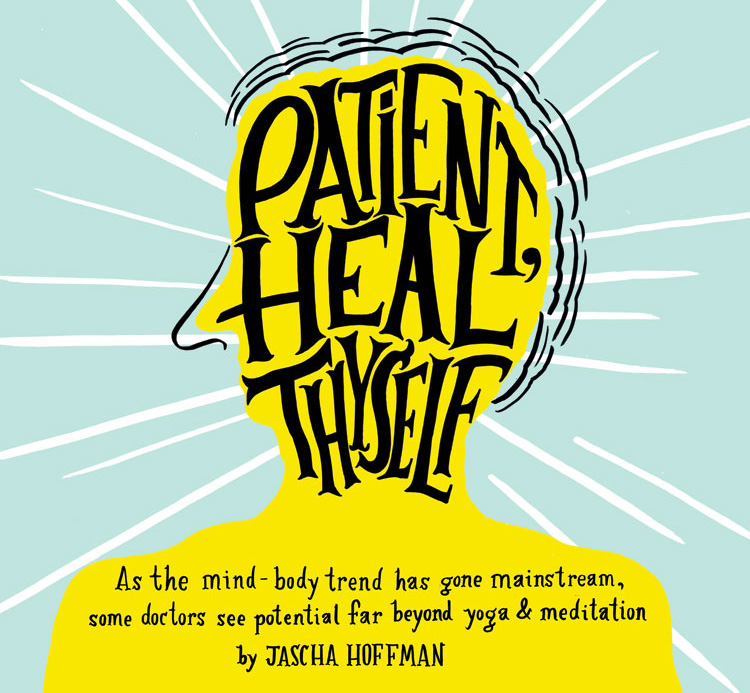At the end of the trip, both groups seemed to benefit. But the men asked to live in 1959, rather than recall it, showed greater improvement on posture, strength, and flexibility tests. They also scored better on vision, hearing, and intelligence. Langer appeared to have temporarily reversed the aging process, simply by asking her subjects to believe they were younger.
This experiment—which will soon have a second life as a feature film starring Jennifer Aniston in the role of Dr. Langer—has inspired many studies on the psychological elements of aging. But it also suggests that we have more power than we realize over our own health. Such ideas have become popular among the growing ranks of Americans practicing yoga, meditation, and other mindfulness-based activities. And these practices are gaining credence in mainstream scientific circles now, too. NYU’s Hospital for Joint Diseases provides a mind-body physical therapy program for those with disabilities. Physicians at the NYU Langone Medical Center recently introduced yoga, acupuncture, and hypnosis to aid in infertility treatment. And the center’s MindBody Education and Patient Care Program offers everything from pre-surgery meditation exercises to holistic nursing services to a 24-hour relaxation channel airing on the hospital’s in-house television. The trend might be best evidenced by the National Institutes of Health, which has spent more than $1 billion on research into alternative and complementary treatments in the past decade.
Few doctors deny that a holistic approach to healing must be taken seriously. But the interactions between mind and body are notoriously hard to untangle. Nowhere is that more apparent than in the results produced by fake pills and other interventions, known collectively as the placebo effect. Preliminary research from doctors and biologists investigating the many quirks of placebo are opening new ways to understand and treat the mind and body together. And as the research mounts, more are becoming convinced of the possibility that a new frontier exists in medicine: mind-powered healing.
You might recall that as a child, a kiss could relieve the pain of a skinned knee. But what about relieving tendonitis in the knee? Science is now beginning to offer proof that the mind—both conscious and unconscious—can have a powerful effect on a range of conditions including anxiety, asthma, chronic pain, depression, high blood pressure, irritable bowel syndrome, and sleep disorders.

The path to understanding these effects appears to lie with placebos, which behave like an ordinary drug in some respects. Designer placebos with impressive colors, packages, and price tags have been shown to be more effective than their generic counterparts. And this method is not limited to the traditional sugar pill. Saltwater injections can often relieve pain almost as well as morphine. Fake ultrasounds can alleviate toothache. Fake operations, in which the leg is opened but nothing is repaired, can decrease knee pain. In some cases, placebos could coax the body into releasing its own healing chemicals. Recent studies show that patients with Parkinson’s disease can respond to a placebo version of the drug L-dopa by producing dopamine in the brain, which alleviates pain caused by the condition. In other cases, the work of placebos might be significantly more complex, relying on a delicate blend of expectation and belief. For a time, scientists assumed that some people are simply more gullible than others. But now there is growing evidence that we can all respond to placebo.
In the 18th and 19th centuries, doctors often used placebos to placate patients who didn’t respond to other treatments, or who were thought to have imagined their illnesses. Seen by many as a useful fib, they became unfashionable among the medical establishment around the turn of the 20th century, when influential doctors such as Oliver Wendell Holmes, Sr., deemed them unscientific and dishonest. But in the 1950s, the placebo swept into a new role in medical history, at the dawn of the double-blind, randomized controlled clinical trial. Epidemiologist Austin Bradford Hill established this standard in a tuberculosis study: When measuring the effectiveness of a new drug, as a way to ensure that the improvement wasn’t due to purely psychological effects, researchers treated some patients with sugar pills. To pass muster, a new treatment had to be not just better than nothing at all, but better than placebo. In an implicit acknowledgment of doctors’ belief in the curing potential of suggestion, a deceptive and old-fashioned cure of last resort had become the standard of effectiveness in clinical trials.
Five decades later, the placebo has been elevated by some to a miracle cure. A January 2000 cover of The New York Times Magazine read: “Placebos work! So why not use them as medicine?” Shortly thereafter a self-help book arrived, Lolette Kuby’s Faith and the Placebo Effect: An Argument for Self-Healing, which promised placebo-induced solutions for a variety of diseases. The treatment had been pulled into what medical historian Anne Harrington calls “a resolutely individualistic miracle narrative.” And physicians believe in them, too: According to one survey of 1,200 American internists and rheumatologists published in the British Medical Journal, in 2008, about half of them regularly prescribed placebos.
Nevertheless, many have raised questions about the reality of the placebo cure. After all, with the passing of time, NYU reproductive surgeon Frederick Licciardi says, symptoms can diminish on their own even when patients are “not given a placebo.” To measure their true effectiveness, one would need to select a group of patients to receive no treatment at all, a practice that is rare due to ethical and practical constraints. So the medical profession is faced with a strange conundrum: The standard used to measure the effectiveness of new medicines itself remains dimly understood.
This could soon change. For the first time in centuries of use, researchers have begun to investigate the inner workings of placebo. Some are delving into the brain’s chemistry to discover exactly which chemical pathways underlie placebo responses. Others are trying to get a more nuanced sense of the clinical conditions under which the effect flourishes. In recent years, biologists have proposed other explanations for the placebo response, from the reduction of inflammation to the effects of natural opioids such as endorphins.
In many of these discussions, however, the patient is generally viewed as a passive recipient of suggestion. Ellen Langer would like to shift that thinking. “Wouldn’t it be more advantageous to recognize that when placebos work we are the ones controlling our health, to learn how to exercise it directly, and to see ourselves as efficacious when we do?” says Langer, a professor of psychology at Harvard University who studied chemistry as an undergraduate at NYU.
Langer’s proposal to let patients heal themselves using the power of expectation seems to fit the rich American tradition of positive thinking, from the early proponents of “mind-cure” like Christian Scientist Mary Baker Eddy to contemporary books like The Secret, which promise health and prosperity to those who merely ask the universe for what they want. But there can be power in what skeptics dismiss as mere wishful thinking. “If people are depressed and upset, and they’re given hope in the form of a pill, it can be a powerful healing mechanism,” says reproductive surgeon Licciardi. “They start to see alternatives.”
Even better is the idea that if we set our minds to it, we can exert control over our own healing—and Langer’s work supports this theory. In addition to the monastery experiment, which suggests that imagining oneself to be younger can turn back the biological clock, she conducted another study in which subjects who wore pilot uniforms scored better on their eye exams after performing flight simulations than those who were told the simulator was broken. And in her recent book, Counterclockwise: Mindful Health and the Power of Possibility, she outlines another project that achieved placebo-like results with no pills at all: In 2007, Langer followed a group of 84 hotel maids to track how their attitudes about exercise and work shaped their health. She told half that their normal housekeeping duties met the Centers for Disease Control’s recommendations for an active lifestyle. After a month, the group who believed that their work counted as exercise not only saw themselves as healthier but lost about two pounds each and had improvements in body-mass index and blood pressure—without any changes to the level of physical activity they reported. Langer doesn’t offer a definitive explanation for this result, but it appears to bolster the case that the power of suggestion, even without a sugar pill, can have a measurable effect on health.

Langer sees this effect as an example of the larger phenomenon of “verbal priming,” whereby simple acts of description and naming have consequences. These effects can be helpful or harmful, she maintains, depending on the language that doctors use to convey diagnoses. There is a significant difference, she claims, between telling a patient that his cancer is “in remission”—a term that implies the possibility of future illness—and telling him that it’s “cured.” Granted, an oncologist might object that this is misleading—while a patient can be cancer-free, there is no cure for cancer—but word choice can make a critical difference in health outcomes, Langer asks: “Did cancer kill my mother? Or did the language that we use to describe cancer lead her to give up?”
Some medical experts have taken issue with the idea that belief can heal, and with the implications of such belief. “If cancer spreads, despite every attempt to think positively, is the patient at fault?” physician and author Marcia Angell wrote in The New England Journal of Medicine, adding that patients in thrall to alternative cures “may come to see medical care as largely irrelevant.” Langer insists that she is not anti-medicine, but that she is against “giving ourselves over fully, unthinkingly, mindlessly, as if [doctors] know more than they can know.” She believes that the greatest risks come when a patient obediently accepts a grim diagnosis. “There’s a tremendous amount of uncertainty, and whatever certainty we have is a function of our mind-sets,” she explains. “When people are given absolutes, and when the information is all negative, it becomes very real.”
While doctors continue to debate their role in mind-body treatments, the field’s growing popularity has become impossible to ignore. In the decades since Jon Kabat-Zinn, author of Full Catastrophe Living, began to medicalize Buddhist mindfulness practices, meditation has emerged into the mainstream of American medicine. While early research generally showed it to be a force for stress reduction, new studies say it can also affect a range of conditions. A recent study partially funded by the Department of Defense revealed that meditation practice boosts short-term memory among Marines and allows them to stay calm and alert in the chaos of combat. Another study found that meditation produced an increase in gray matter density in the hippocampus—associated with memory and learning—while reducing gray matter in the amygdala, a region of the brain connected to anxiety and stress. Yael Shy, founder and director of the Spirituality Project at NYU, established a weekly program of nondenominational sitting meditation on the Washington Square campus for just this reason. “The harsher the city and the more overscheduled the people, the more we need meditation practices in our lives to keep us sane and happy,” she says.
Meditation is not the only form of introspection that can heal. Psychotherapy has been shown to be an effective treatment for depression and anxiety, and mental treatments may heal other physical ailments. John Sarno—a professor of rehabilitation medicine at the NYU School of Medicine and author of the best-selling 1991 book Healing Back Pain: The Mind-Body Connection—says that a short period of emotional reckoning could provide a permanent solution to back pain usually attributed to spinal misalignments and muscular knots. This is because, he believes, back pain is often the mind’s way of diverting a person’s attention from deeper emotional damage. Among patients he treats, Sarno’s diagnosis is consistent and could be summed up as: “The problem is in your head.”
“Clearly, the brain considers unconscious feelings to be infinitely more dangerous or painful than pain,” Sarno writes in his recent book, The Divided Mind: The Epidemic of Mindbody Disorders, “or why would it practice so sedulously to deceive?”
Sufferers of back pain might interpret this analysis as bad news, because the emotional problems at the core of Sarno’s diagnosis could take years of therapy to work through. But in his experience, the patient doesn’t need to rid himself of emotional pain. To heal the back, all he has to do is grasp and accept the emotional origins of the pain. “It’s almost too good to be true,” writes Sarno, who argues that patients need “not a leap of faith, but a leap of understanding.” To this end, Sarno asks his patients to write essays on the emotional disturbances that might be to blame for their aches, from childhood abuse to garden-variety perfectionism. He has thousands of ardent followers, including radio personality Howard Stern, who was so grateful for a cure to his chronic back pain that he dedicated his first book, Private Parts, to the doctor.
Sarno’s approach certainly offers something that conventional pain pills can’t: the promise of no side effects. And the same argument might be made for placebos. But that conclusion is not always so simple. According to Ben Goldacre, a British doctor and columnist who dismantles practices such as homeopathy in his recent book Bad Science, alternative therapists don’t just give treatments that rely on the placebo effect. They also give “placebo diagnoses,” which he describes as “ungrounded, unevidenced, often fantastical assertions about the nature of the patient’s disease.” This points to a broader ethical dilemma in the practice of medicine. It’s generally agreed that doctors have a responsibility to heal patients with the most effective treatment available. It’s also agreed that they should tell their patients the truth. The mandates of honesty and effectiveness might not always point in the same direction, however. Stacks of placebo studies show that deception can lead to recovery. But it would be hard to come up with a code of ethics that permitted outright deception. And if nothing else seems to work, might it be seen as unethical to withhold a placebo treatment?
This dilemma raises a crucial question: Can you have a placebo without a lie? Ted Kaptchuk, a professor at the Harvard Medical School who has been trained in traditional Chinese medicine, has shown that it’s possible to give patients the benefits of placebo without the deception. For a recent study, he divided 80 patients with irritable bowel syndrome into two groups; one received no treatment at all, while the other was given placebos twice a day. After three weeks, nearly 60 percent of patients taking the sugar pills reported that their symptoms had been “adequately relieved,” compared to about 40 percent for those given no treatment. He determined that the placebo has the potential to become a real treatment for IBS. These findings suggest that “the very performance of the medical ritual can significantly reduce symptoms,” Kaptchuk says.
NYU’s Licciardi sees mind-based paths to healing as a necessary new component of the doctor-patient experience, and NYU’s emerging programs represent just the first steps of what should become a more integrated approach to treatment. “If it’s done by the right person in the right way, I don’t see any negatives,” he says. “Our patients are going to outside sources for these services all the time, without the knowledge of their physicians.” By bringing services like acupuncture and hypnosis in-house, physicians are acknowledging, “We’re all in this together; we want to treat your whole body and mind,” Licciardi adds.
When a more comprehensive command of neurochemistry joins a scientific understanding of how we use our innate emotional tools, we might be able to make good on the notion that we learn to heal ourselves. “It’s not the placebo that’s curing us,” Langer emphasizes. “We’re curing ourselves whenever the placebo is at work. We [just] have to find a way to harness this control.”








